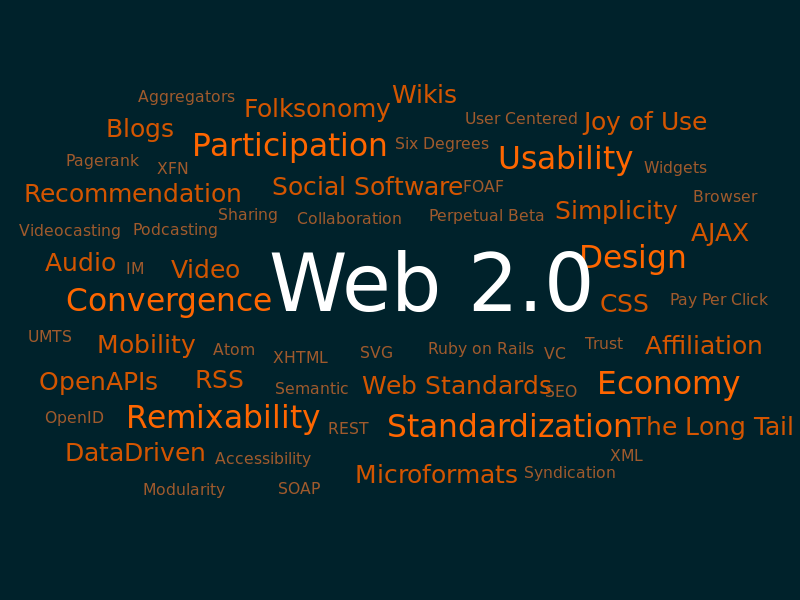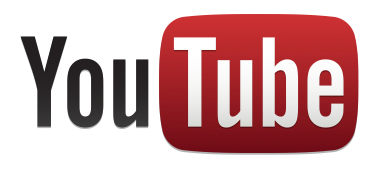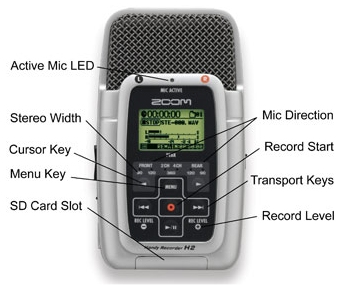Consumer products is the use of technology in the home, for example, people may use cameras, editing software and other forms of technology. Technology is a great way to start a career or hobby in the media industry easily from home.
Web 2.0 is a new version of the world wide web, it does not refer to a specific update to a technical specification, but to cumulative changes in the way certain web pages are created and used, Web 2.0 refers to the movement from fixed HTML web pages to a more active web that is more ordered and based on serving certain we applications to users.
 |
| A Tag Cloud showing Web 2.0 themes. |
Satellite/s is/are a form of technology which allow signals to be received from an external antenna to a television via a wire, this signal carries television channels which can be viewed on to TV. Satellite TV is a cheaper option for television instead of using cable. Satellite allows for things such as SKY and Virgin TV which allows recording and an extensive range of programs which can be available for a monthly charge. Although satellite signals can be dramatically changed with bad weather and can completely cut off in windy or raining weather.Cable services are a lot more simply, they only include a TV and a cable whereas satellite needs other technology which needs to be set up. Cable users also have to pay taxes.
Analogue is recorded through a wave, this is what we watch television on, therefore television signal is continuous. The information being processed through electrical signals using analogue is changed into electrical pulses of varying amplitude.

With Digital technology, the analog wave is sampled at some interval, and then changed into numbers that are stored in the digital device. On a CD, the sampling rate is around 44,000 sps (samples per second). So on a CD, there are 44,000 numbers stored per second of sound. To hear that sound which has been put onto the cd the numbers are changed into a voltage wave that approximates the original wave. Televisions these days are all digital, they were originally part Analogue too but this happened in 2011, so now all of the analogue channels have been removed, this happened so that all households are able to receive Freeview services. Freeview boxes are very cheap with a one of payment from around £10-30.
Internet and Interactive
The internet is a global network which connects millions of computers and devices which can access the internet. The internet includes endless amounts of services which can be accessed for free or for a fee. The internet contains well known sites such as Youtube, Facebook, Blogger and many many more.


It can be used to access many forms of media such as the news, films, television series, media related companies, games etc. Obviously there is much more to the internet than media but recent research suggests that the most used area of the internet is that of film and television, there are both legal and illegal ways to view films and television online.
Legal ways of viewing television online would be '4od' or 'BBC Iplayer', both these services allow you to catch up on live or recently aired programmes or films. Illegal ways of viewing television would not include adverts pr sponsorships, although watching these may be time consuming the tv production uses them to fund, but many people still want to be able to watch tv without the adverts.
You can watch films legally online in many different ways, a couple of the popular sites are Lovefilm, and Netflix, for a small monthly fee these websites allow you to stream films and television series to many different devices. Watching TV illegally online can be done on certain different illegal websites where certain people have obtained films for free and stream them for free so that you do not have to pay to buy a DVD or go to the cinema.

Watching Tv and Film online allows something called manipulation of media, this is where the viewer can choose to pause rewind play and fast forwarded any film or television series they are watching, this also applies to SKY where you are allowed to pause and rewind live TV.
High Definition and 3D
HD or Higher Definition provides a higher resolution that shows a much sharper and clearer image than that of regular definition. HDTV comes in many different formats; 1080p, 1080i, or 720p, these are the main three highest defintion formats, the lowers include 240p, 360p or 480p. The 'p' stands for progressive scan whereas the 'i' indicates interlaced.
The most common types of HDTV are 720p and 1080p, 720p is more than twice the resolution than standard tv quality and is recommended over 1080i because progressive scan is quicker and can proccess the image faster than interlaced resolution. 1080p shows the best picture quality to this day, but it is very similar quality to 720p.
Accessing HDTV can be done by purchasing HD equipment, such as Tv, Blu-ray player etc., but all of this can be expensive. Online services like Youtube often have a HD setting which can be changed on your computer so that you can either lower or raise the level of resolution quality you have. Freeview nowadays has a few HD channels like BBC Three and BBC One, but to access a higher amount of HD channels on your TV you will most likely need to buy a SKY box subscription or something along those lines which allows you to access it.

Pay Per View and On-Demand Viewing
Pay per view first came about in the 1970's and then became available to satellite and cable services in 1990's. Pay per view is accessed to television and movies to access first run movies and special events for a limited time. This is a good way of being able to watch a certain programme or film at a time when it is convenient for the viewer. A well known and widely used type of pay per view is cinemas, this is where you can pay a one off small fee to watch a newly released film. Television also uses pay per view, for example the Wrestling programme 'WWE' can be watched on demand for a small cost. Overall it is a good way of watching certain things but once you have watched your film and your rental time is over you wont get it back unless you pay again.
On demand viewing is where certain channels, programmes, or films can be watched on demand whenever you want for free, and example of on demand is BBC Iplayer and 4OD.
These allow you to watch programmes from the last 7 days (or more) on a number of different devices such as XBOX, Most smartphones, Laptops etc., This is a good way to watch TV or Films you have missed because you can watch them whenever you want, also it allows you to interact with what you're watching by pausing, fast forwarding, re-winding, accessing subtitles etc..

Streaming Content
Streaming is playing shared videos or music through internet sources such as Youtube. Watching this content is free and mostly unlimited although it does require a fast internet connection to be able to watch an entire video without buffering/stopping to load. Also, even if you have a fast internet connection, if too many people are watching a certain stream it may affect your connection and quality to the stream. Subscription to Streams such as Lovefilm and Netflix come at a monthly cost but allow you to watch lots of different programmes and films when you want with a pretty good connection. You can also download content to your computer, this takes up space on your hard drive or device which you are storing it on, whereas streaming doesn't take up any space.

Digital Recorders
Digital recorders allow you to record audio or video, these came about in the 1980's. Digital Recorders allow you to zoom in on different parts of the image or to slow them down etc, Digital Audio recorders are very similar as they don't use tapes to store their info instead they use certain technology such as memory sticks/cards, this type of technology is cheaper than other forms of recording. Digital audio recorders can be used to capture all sorts of audio wherever or whenever you want. The information you record will be saved as either MP3, WAV or WMA. This information will then be saved onto a hard drive which has a large memory store so these are better than cassette recorders because you can store more.

Internet and Interactive
The internet is a global network which connects millions of computers and devices which can access the internet. The internet includes endless amounts of services which can be accessed for free or for a fee. The internet contains well known sites such as Youtube, Facebook, Blogger and many many more.


It can be used to access many forms of media such as the news, films, television series, media related companies, games etc. Obviously there is much more to the internet than media but recent research suggests that the most used area of the internet is that of film and television, there are both legal and illegal ways to view films and television online.
Legal ways of viewing television online would be '4od' or 'BBC Iplayer', both these services allow you to catch up on live or recently aired programmes or films. Illegal ways of viewing television would not include adverts pr sponsorships, although watching these may be time consuming the tv production uses them to fund, but many people still want to be able to watch tv without the adverts.
You can watch films legally online in many different ways, a couple of the popular sites are Lovefilm, and Netflix, for a small monthly fee these websites allow you to stream films and television series to many different devices. Watching TV illegally online can be done on certain different illegal websites where certain people have obtained films for free and stream them for free so that you do not have to pay to buy a DVD or go to the cinema.

Watching Tv and Film online allows something called manipulation of media, this is where the viewer can choose to pause rewind play and fast forwarded any film or television series they are watching, this also applies to SKY where you are allowed to pause and rewind live TV.
High Definition and 3D
HD or Higher Definition provides a higher resolution that shows a much sharper and clearer image than that of regular definition. HDTV comes in many different formats; 1080p, 1080i, or 720p, these are the main three highest defintion formats, the lowers include 240p, 360p or 480p. The 'p' stands for progressive scan whereas the 'i' indicates interlaced.
The most common types of HDTV are 720p and 1080p, 720p is more than twice the resolution than standard tv quality and is recommended over 1080i because progressive scan is quicker and can proccess the image faster than interlaced resolution. 1080p shows the best picture quality to this day, but it is very similar quality to 720p.
Accessing HDTV can be done by purchasing HD equipment, such as Tv, Blu-ray player etc., but all of this can be expensive. Online services like Youtube often have a HD setting which can be changed on your computer so that you can either lower or raise the level of resolution quality you have. Freeview nowadays has a few HD channels like BBC Three and BBC One, but to access a higher amount of HD channels on your TV you will most likely need to buy a SKY box subscription or something along those lines which allows you to access it.

Pay Per View and On-Demand Viewing
Pay per view first came about in the 1970's and then became available to satellite and cable services in 1990's. Pay per view is accessed to television and movies to access first run movies and special events for a limited time. This is a good way of being able to watch a certain programme or film at a time when it is convenient for the viewer. A well known and widely used type of pay per view is cinemas, this is where you can pay a one off small fee to watch a newly released film. Television also uses pay per view, for example the Wrestling programme 'WWE' can be watched on demand for a small cost. Overall it is a good way of watching certain things but once you have watched your film and your rental time is over you wont get it back unless you pay again.
On demand viewing is where certain channels, programmes, or films can be watched on demand whenever you want for free, and example of on demand is BBC Iplayer and 4OD.
These allow you to watch programmes from the last 7 days (or more) on a number of different devices such as XBOX, Most smartphones, Laptops etc., This is a good way to watch TV or Films you have missed because you can watch them whenever you want, also it allows you to interact with what you're watching by pausing, fast forwarding, re-winding, accessing subtitles etc..

Streaming Content
Streaming is playing shared videos or music through internet sources such as Youtube. Watching this content is free and mostly unlimited although it does require a fast internet connection to be able to watch an entire video without buffering/stopping to load. Also, even if you have a fast internet connection, if too many people are watching a certain stream it may affect your connection and quality to the stream. Subscription to Streams such as Lovefilm and Netflix come at a monthly cost but allow you to watch lots of different programmes and films when you want with a pretty good connection. You can also download content to your computer, this takes up space on your hard drive or device which you are storing it on, whereas streaming doesn't take up any space.

Digital Recorders
Digital recorders allow you to record audio or video, these came about in the 1980's. Digital Recorders allow you to zoom in on different parts of the image or to slow them down etc, Digital Audio recorders are very similar as they don't use tapes to store their info instead they use certain technology such as memory sticks/cards, this type of technology is cheaper than other forms of recording. Digital audio recorders can be used to capture all sorts of audio wherever or whenever you want. The information you record will be saved as either MP3, WAV or WMA. This information will then be saved onto a hard drive which has a large memory store so these are better than cassette recorders because you can store more.



Bruce,
ReplyDeleteWhere are all of the wonderful pictures of the technology and how each one works? Add these please (one for each slide/term).
You have said that cable users don't pay taxes - this is copied and not true in regards to cable TV service providers in the UK.
Once the pictures are on, you will have achieved a merit.
EllieB